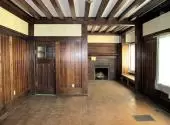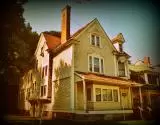Preserving A Piece of Stickley History

A unique icon in American architecture and interior design, the Gustav Stickley House in Syracuse represents the pivotal transition from 19th century Victorian taste to a modern sensibility with Stickley’s first Craftsman interior built within his family’s Queen Anne period home. Gustav Stickley (1858-1942) as most of you know, was a major spokesman for and promoter of the American Arts & Crafts Movement and an active proponent of William Morris’ English Arts & Crafts philosophy. It was through Gustav Stickley that the Arts & Crafts Movement in Central New York gained initial influence and success.
Stickley’s unassuming Queen Anne house was completed in 1900. And following a Christmas Eve fire in 1901, Stickley redesigned and reconfigured his family home with a new Craftsman interior, the first of its kind in the United States. The interior is unique and represents the aesthetic shift in America that precipitated the spread of the Arts & Crafts style across the country. The interior was featured in the December 1902 issue of The Craftsman magazine and it was during this period from 1900 until 1905 that he achieved his initial fame and fortune.
By 1900, Gustav Stickley was making simply designed mission oak Arts & Crafts furniture in the Syracuse suburb of Eastwood, first labeling his furniture “United Crafts” and later calling it “Craftsman”. His sturdy and unornamented furniture had carefully articulated joints to emphasize structure. In October 1901, Gustav Stickley began publishing The Craftsman (1901-1916), a magazine dedicated to the ideal of honest craftsmanship.
It was appropriate that the first issue of The Craftsman was devoted to William Morris and the second to John Ruskin. As might be expected, illustrations of Craftsman furniture appeared in the magazine along with articles about crafts people and exhibits of their work. The Craftsman eventually included house plans, which subscribers could order to create the proper setting for their Craftsman furniture. For a brief period, 1903-1904, Harvey Ellis (1852-1904), a talented Rochester architect, worked for Gustav Stickley, contributing elegantly inlaid furniture designs to the Craftsman line. To complete the Craftsman interior, Gustav Stickley’s company, United Crafts and later Craftsman Workshops, sold metalware and light fixtures.
In 1905, Mr. Stickley moved his business and sales operations to New York City to be closer to the market. However, he retained his residence in Syracuse for several years until his family joined him in New Jersey at Craftsman Farms. He also kept his manufacturing operations in Eastwood, New York. His venture to New York City eventually led to bankruptcy in 1915 and loss of his business and fortune. After his wife’s death, Gus took up residency in his former home on Columbus Avenue, purchased in 1919 by his daughter Barbara Stickley Wiles. There he remained, on and off, until his death in 1942. The family sold the house in the 1950s and it was subdivided into five apartments. The house, which is currently unoccupied, was purchased in 1996 by the L. & J.G. Stickley Company to save its historic interior from being dismantled and sold at auction. 438 Columbus Avenue survives today in generally sound condition and with surprisingly good design integrity.
Few American interiors that are as significant as this one survive. Its place in the overall development of American design history, its association with the American Arts & Crafts Movement in general and in particular its specific association with Gustav Stickley is unparalleled. Syracuse, New York and environs were a design and manufacture center of many quality Arts & Crafts furnishings, in good part due to the successful efforts of Gustav Stickley and his extended family. The Gustav Stickley House is an architectural treasure which merits and deserves preservation and protection for the benefit of future generations.
Today, with the help of local preservationists, historians, Craftsman-period enthusiasts, and Stickley descendants, the house is about to undergo a dramatic restoration. Phase One work is expected to take place throughout 2016 and 2017 and will include structural stabilization, asbestos abatement, masonry repair, new roofing, window preservation, wood trim repairs and replication, completion of an historically accurate paint scheme, and reconstruction of the period front porch. Several New York State grants have been secured and additional funding has been provided by three local private foundations including a $10,000 donation from the Arts & Crafts Society of Central New York.
Ownership of the property will be transferred from L. & J.G. Stickley Co. to the not-for-profit, 501-c3, University Neighborhood Preservation Association who will manage the Phase One project. This ambitious plan is not without challenges, therefore, a new non-profit organization — the Gustav Stickley House Foundation — is being formed to provide assistance to the principal parties. The Foundation will serve as an advisory body regarding preservation and programming of the property. Its principal role, however, will be raising sufficient funds to ensure successful completion of the restoration as well as on-going use and maintenance. There remains a $65,000 funding gap for Phase One as well as the necessary funds to complete the important documentation for the Historic Structure Report. Fundraising and restoration of the interior will be completed under a second phase anticipated to be completed in 2019.
For more information on the Gustav Stickley House, please contact the Foundation directly via email at [email protected]. Check out our Facebook page for a link to even more information on this exciting project! And stay tuned as we continue to update you on the latest projects, restoration and news from the Gustav Stickley House Foundation.
Tax-deductible donations to the restoration project can be made to the University Neighborhood Preservation Association, 230 Westminster Avenue, Syracuse, NY 13210.

